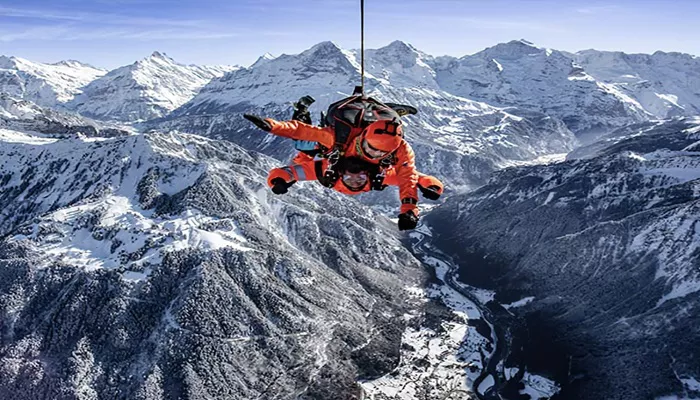SkyJump is an extreme sport where participants leap from very high platforms or buildings. Unlike traditional skydiving, SkyJump often uses a tethered system to control the fall. The speed of the descent is thrilling and a key part of the experience. In this article, we will explore how fast SkyJump can be, factors influencing speed, and what makes it unique compared to other aerial sports.
What Is SkyJump?
SkyJump is a controlled free fall from a great height. It combines the excitement of skydiving with the safety of a guided descent. Jumpers are connected to cables that slow their fall and keep them close to the building or structure. This makes SkyJump accessible to people who want to feel the rush of falling without the risks of full freefall skydiving.
Typical SkyJump Heights
SkyJump platforms are usually placed on tall buildings or towers. Heights vary, but many popular SkyJump locations start around 200 meters (656 feet) and can go up to 300 meters (984 feet) or more. The altitude impacts the total time and speed of the jump.
Comparison to Skydiving Altitude
Traditional skydiving typically begins at altitudes of 3,000 meters (about 10,000 feet) or higher. This is much greater than SkyJump heights, but the difference in altitude does not mean SkyJump is slow. SkyJump is designed for shorter, intense falls, giving a quick adrenaline rush rather than the long freefall of skydiving.
How Fast Does SkyJump Go?
The speed of a SkyJump depends on several factors, including the height of the jump, the weight of the jumper, and the resistance of the cable system. Speeds can reach up to 85 kilometers per hour (about 53 miles per hour) in some cases. This is fast enough to give a strong adrenaline kick but controlled enough to keep the jump safe.
Factors Affecting Speed
Height: The taller the jump, the more time gravity has to accelerate the jumper, increasing speed.
Weight: Heavier jumpers tend to reach higher speeds because gravity pulls them down faster.
Equipment: The cable system and harness design affect how much the jumper’s speed is slowed.
Wind Conditions: External factors such as wind can change the actual speed during descent.
Typical Speeds at Famous SkyJump Locations
For example, the SkyJump at the Stratosphere Tower in Las Vegas has jumpers reaching speeds around 80 km/h (50 mph). At Macau Tower, one of the highest commercial SkyJump sites, speeds can peak close to 85 km/h. These speeds create an exciting but safe experience that attracts thrill-seekers worldwide.
What Does It Feel Like to Reach These Speeds?
The sensation of falling at 80+ km/h is intense. Jumpers feel strong wind rushing past them and a rapid drop toward the ground. The cable system gently controls the descent, so the thrill comes without the danger of an uncontrolled fall. Many describe it as the perfect mix of fear and excitement.
Physical Sensations During SkyJump
As the jumper accelerates, they experience increased air pressure against their body. The heart races and adrenaline floods the system. Because the fall is controlled, jumpers can also enjoy views and surroundings that traditional skydivers might miss during their longer freefall.
Mental Experience
Many first-time SkyJumpers report overcoming fear and gaining confidence from the experience. The quick speed gives a sense of achievement while the safety harness reassures the jumper. This balance is why SkyJump has become popular with those who want an extreme sport without high risk.
SkyJump Versus Traditional Skydiving: Speed and Safety
While both sports involve falling from heights, the speeds and experiences differ. Traditional skydiving reaches terminal speeds around 190 km/h (118 mph), much faster than SkyJump. However, skydiving requires jumping from aircraft at very high altitudes, including freefall and parachute deployment phases.
SkyJump limits speed to a safer range by using cables. This controlled speed lowers risk and expands accessibility. For those curious about extreme sports but concerned about safety, SkyJump is an ideal option.
Skydiving Altitude Impact on Speed
Skydiving altitude matters because jumpers have more time to accelerate in freefall before parachute deployment. In contrast, SkyJump altitudes are lower, and the cable slows descent, so speeds stay below terminal velocity. Despite this, the thrill remains intense and satisfying.
Preparing for a SkyJump: What You Should Know
Anyone interested in trying SkyJump should prepare mentally and physically. The speed and height can be intimidating, but training and briefing help jumpers stay calm. Wearing proper gear and following expert instructions ensures safety during the jump.
Physical Fitness
Jumpers should have basic fitness levels. Strength helps maintain body position during the fall, and flexibility aids in handling landing. However, SkyJump is designed to be accessible, so even beginners can participate.
Training and Safety Briefings
Before jumping, participants attend a safety briefing. They learn about equipment, how to control their body position, and what to expect. Professional guides assist at all times to reduce risks and enhance enjoyment.
Where Can You Experience SkyJump?
SkyJump is available in several famous locations worldwide. Some of the top spots include:
- Stratosphere Tower, Las Vegas, USA
- Macau Tower, Macau SAR, China
- Table Mountain, Cape Town, South Africa
Each location offers unique views and slightly different speeds depending on height and equipment.
Conclusion
SkyJump offers an exhilarating experience with speeds reaching up to 85 km/h. Its combination of thrill and safety makes it a standout extreme sport. Whether you are a beginner or an adrenaline junkie, SkyJump delivers a memorable fall.

